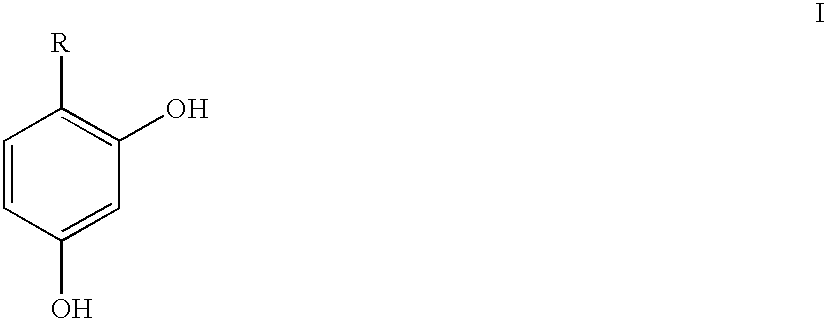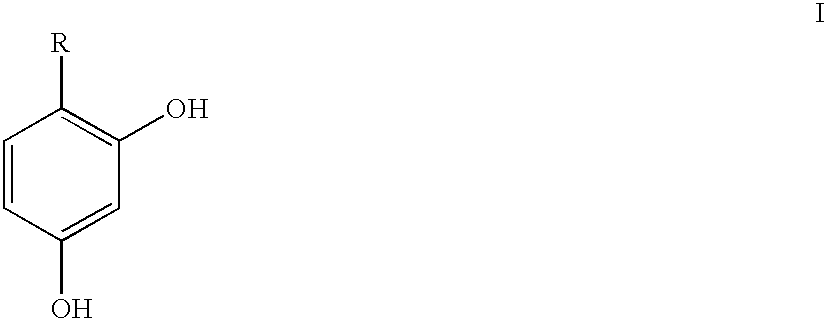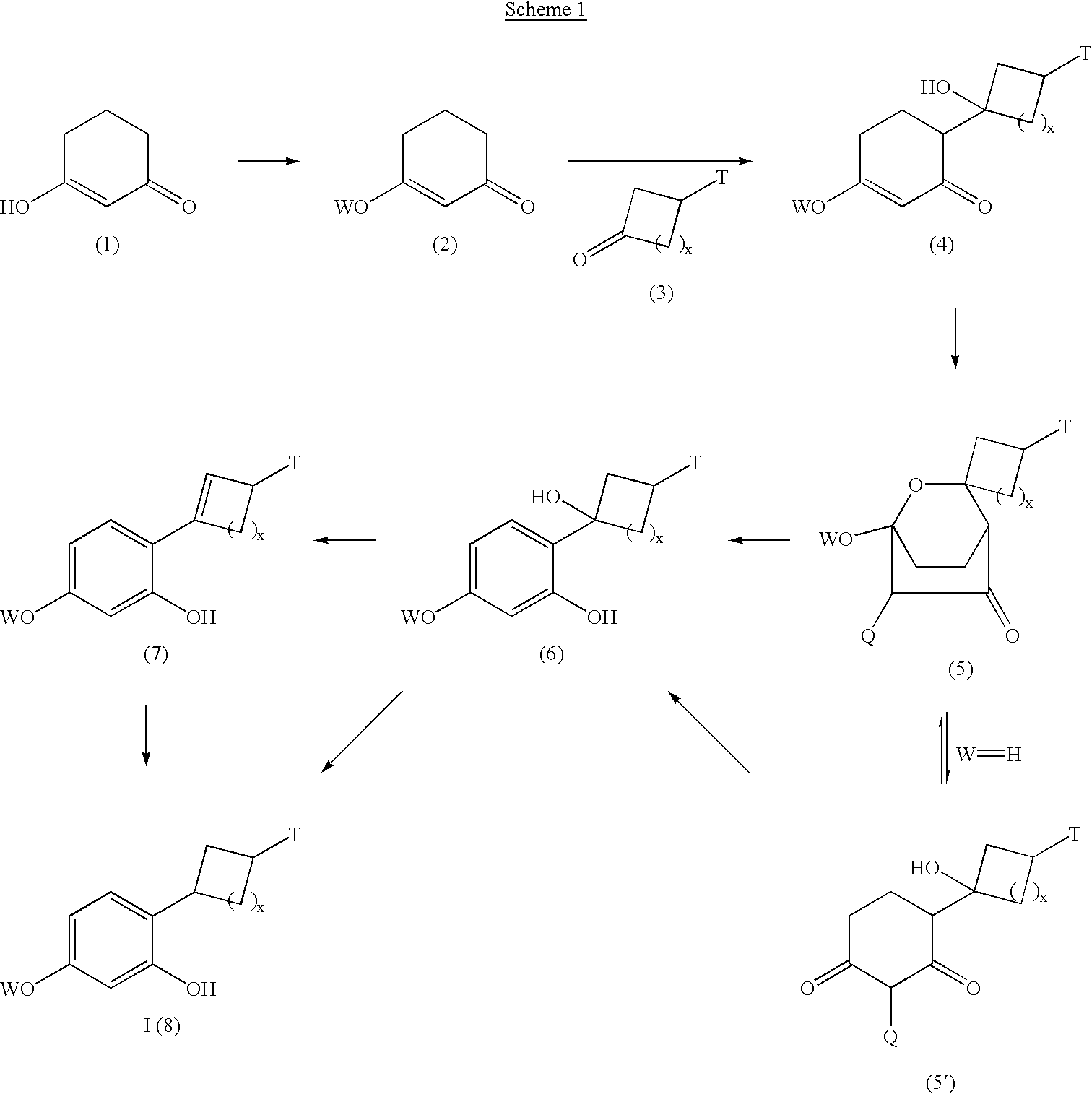Resorcinol derivatives
a technology of resorcinol and derivatives, which is applied in the field of resorcinol, can solve the problems of affecting the appearance of skin, affecting the effect of skin pigmentation, and thiol compounds such as glutathione and cysteine not showing satisfactory depigmentation effect, and achieve the effect of reducing the pigmentation of the skin
- Summary
- Abstract
- Description
- Claims
- Application Information
AI Technical Summary
Benefits of technology
Problems solved by technology
Method used
Image
Examples
preparation 1
3-(Benzyloxy)-2-cyclohexen-1-one
[0259] To a flask equipped with magnetic stirrer and Dean Stark apparatus was added 1,3-cyclohexanedione (70.0 g, 624 mmol), toluene (500 ml), p-toluenesulfonic acid monohydrate (1.68 g, 8.83 mmol) and benzyl alcohol (65.6 g, 606 mmol). The resulting solution was heated under reflux for 2 hr. The reaction mixture was cooled to room temperature and washed with saturated aqueous sodium carbonate solution (4.times.50 ml). The organic layer was washed with brine (50 ml), dried over magnesium sulfate, filtered and concentrated in vacuo, affording a brown oil which crystallised upon standing. The crude crystalline material was triturated in isopropyl ether (100 ml) and stirred at 0.degree. C. for 2 hr. The mixture was filtered and the crystalline material was washed with ice cold isopropyl ether (3.times.100 ml) followed by cold petroleum ether (100 ml). The resulting solid was dried overnight under reduced pressure to furnish the title compound (85.3 g, 68...
preparation 2
(.+-.)-3-(Benzyloxy)-6(8-hydroxy-1,4-dioxaspiro[4.5]dec-8-yl)-2-cyclohexen--1-one
[0260] To a flask equipped with magnetic stirrer was added tetrahydrofuran (600 ml) and diisopropylamine (38.1 ml, 272 mmol). The stirred solution was cooled to -78.degree. C. and n-butyl lithium (113.4 ml, 272 mmol, 2.4 M in hexanes) was added dropwise via syringe. The resulting yellow solution was stirred for 35 min at -78.degree. C., then 3-(benzyloxy)2-cyclohexen-1-one (50.0 g, 248 mmol) was added as a solution in tetrahydrofuran (100 ml). The solution was stirred for 1 hr prior to the addition of cyclohexane-1,4-dione monoethylene ketal (38.7 g, 248 mmol) as a solution in anhydrous tetrahydrofuran (100 ml). The solution was stirred for 2 hr at -78.degree. C., then allowed to warm slowly to room temperature over 1 hr. Saturated aqueous ammonium chloride (80 ml) was added, followed by dichloromethane (700 ml) and the mixture stirred until no solids remained. The layers were separated and the aqueous ...
preparation 3
(.+-.)-1-(Benzyloxy)-6bromo-3-(1,4dioxaspiro[4.5]dec-8-yl)-2-oxabicyclo [2.2.2]octan-5one
[0261] A round bottomed flask equipped with magnetic stirrer was charged with (.+-.)-3-(benzyloxy)6-(8-hydroxy-1,4-dioxaspiro[4.5]dec-8-yl)-2-cycl-ohexen-1-one (78.4 g, 219 mmol) and dichloromethane (600 ml). To the stirred solution was added N-bromosuccinimide (40.9 g, 230 mmol) in one portion, followed by aqueous hydrobromic acid (3 drops, 48% aqueous solution). The resulting solution was stirred at room temperature for 2 hr, then poured into a separating funnel containing aqueous sodium metabisulfite solution (150 ml) and dichloromethane (200 ml). The layers were separated and the organic layer was washed with brine (200 ml), dried over magnesium sulfate, filtered, then concentrated in vacuo to give a solid. Trituration with methanol (500 ml) afforded the title compound (82.8 g, 86%) as a white solid. m / z (ES.sup.+) 437 and 439 [(1:1), M+H.sup.+].
PUM
| Property | Measurement | Unit |
|---|---|---|
| flash point | aaaaa | aaaaa |
| melting point | aaaaa | aaaaa |
| temperature | aaaaa | aaaaa |
Abstract
Description
Claims
Application Information
 Login to View More
Login to View More - R&D
- Intellectual Property
- Life Sciences
- Materials
- Tech Scout
- Unparalleled Data Quality
- Higher Quality Content
- 60% Fewer Hallucinations
Browse by: Latest US Patents, China's latest patents, Technical Efficacy Thesaurus, Application Domain, Technology Topic, Popular Technical Reports.
© 2025 PatSnap. All rights reserved.Legal|Privacy policy|Modern Slavery Act Transparency Statement|Sitemap|About US| Contact US: help@patsnap.com



